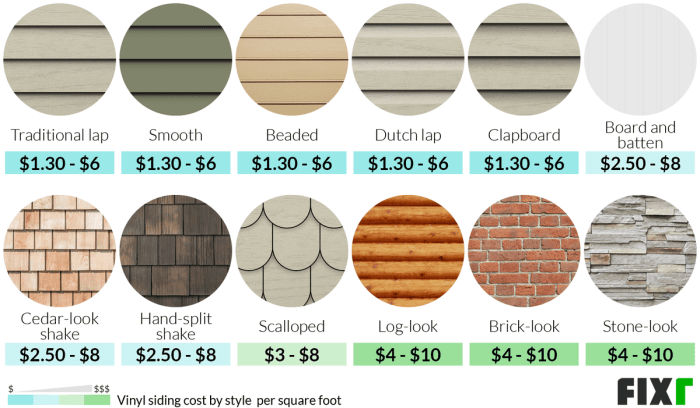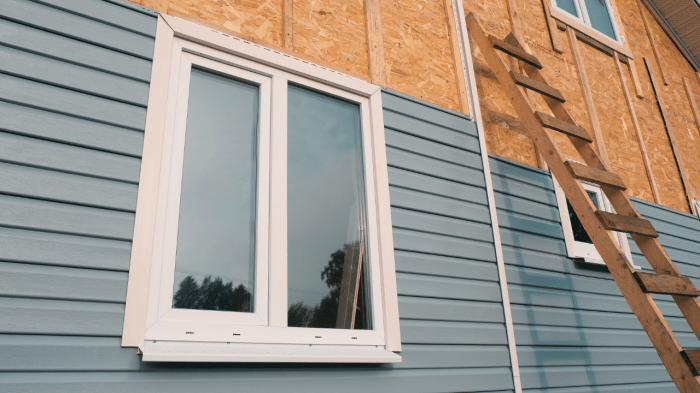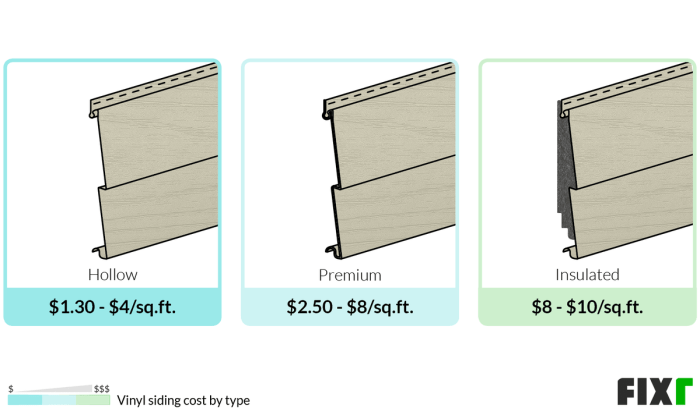Vinyl siding price per square foot isn’t a one-size-fits-all figure. Understanding the true cost requires delving into a multitude of factors, from the grade of vinyl chosen and the complexity of your home’s exterior to regional labor rates and material availability. This guide breaks down the intricacies of vinyl siding pricing, empowering you to make informed decisions for your next home improvement project. We’ll explore the variables influencing cost, compare vinyl siding to alternatives, and provide practical steps to estimate the expense for your specific needs, leaving you well-equipped to navigate the world of exterior cladding.
From initial material selection to the final installation, we’ll examine how each stage impacts the overall price. We’ll also analyze long-term cost implications, considering maintenance requirements and the lifespan of different materials. This detailed analysis will equip you to compare vinyl siding against other options, ultimately helping you choose the most suitable and cost-effective solution for your home.
Factors Influencing Vinyl Siding Price

The cost of vinyl siding installation is influenced by a complex interplay of factors, making it crucial to understand these variables before embarking on a project. Prices aren’t uniform; they fluctuate based on material selection, labor costs, project complexity, and regional economic conditions. This section delves into the specifics, providing a clearer picture of what contributes to the final cost per square foot.
Material Quality and Grade
Vinyl siding quality significantly impacts the price. Higher-quality siding generally offers superior durability, color retention, and warranty coverage, justifying the increased cost. Basic vinyl siding often utilizes thinner materials and simpler designs, leading to lower prices but potentially shorter lifespans and less resistance to weather damage. Premium options, conversely, incorporate thicker materials, enhanced UV protection, and more sophisticated designs, resulting in higher initial costs but potentially long-term savings through extended lifespan and reduced maintenance.
| Grade | Price Range (per sq ft) | Features | Considerations |
|---|---|---|---|
| Basic | $1.00 – $3.00 | Thinner gauge vinyl, limited color options, basic profiles | Shorter lifespan, less resistant to impact and fading |
| Mid-Grade | $3.00 – $5.00 | Thicker gauge vinyl, wider color selection, more design options | Good balance of price and performance |
| Premium | $5.00 – $8.00+ | Thickest gauge vinyl, extensive color options, advanced profiles, enhanced UV protection, longer warranties | Superior durability and longevity, higher initial investment |
Labor Costs and Installation Complexity
Labor costs represent a substantial portion of the overall siding installation expense. Factors such as the contractor’s experience, location, and demand significantly influence these costs. Complex installations, involving intricate designs, multiple layers of siding, or challenging architectural features, demand more time and expertise, thereby increasing labor costs per square foot. For example, a house with numerous dormers, bay windows, or complex trim work will require more precise cutting and fitting, leading to higher labor charges compared to a simple rectangular structure. Similarly, removing existing siding adds to the overall labor time and expense.
Regional Variations in Pricing
Regional differences in material costs, labor rates, and contractor availability contribute to varying vinyl siding prices across different geographic areas. Areas with high construction activity or a shortage of skilled labor tend to have higher installation costs. Furthermore, transportation costs for materials can inflate prices in remote or less accessible locations. For instance, coastal regions might experience higher prices due to potential storm damage considerations and higher demand for durable siding materials.
Cost Comparison

Choosing the right exterior cladding for your home involves careful consideration of various factors, not least of which is cost. While vinyl siding often presents itself as a budget-friendly option, a comprehensive comparison with other materials is crucial for making an informed decision. This section will analyze the price per square foot of vinyl siding against wood, aluminum, and fiber cement siding, highlighting the long-term cost implications of each.
Understanding the price differences between these materials requires examining both initial installation costs and the ongoing expenses associated with maintenance and longevity. The initial cost, while a significant factor, shouldn’t overshadow the long-term financial implications of material choice.
Price Comparison of Exterior Cladding Materials
The following table provides a general price range per square foot for various exterior cladding materials. It’s important to note that these prices can fluctuate based on location, material quality, and labor costs. These figures represent average costs and may vary significantly depending on project specifics.
| Material | Price per Square Foot (USD) |
|---|---|
| Vinyl Siding | $3 – $12 |
| Wood Siding | $10 – $30+ |
| Aluminum Siding | $6 – $15 |
| Fiber Cement Siding | $8 – $25+ |
Cost-Effectiveness Scenarios
The cost-effectiveness of each material depends heavily on individual circumstances. Certain scenarios favor vinyl siding, while others highlight the advantages of alternative options.
- Vinyl Siding as a Cost-Effective Choice: For homeowners on a tight budget seeking a low-maintenance option, vinyl siding often proves to be the most economical choice, particularly for large homes or projects where material costs significantly impact the overall budget. For example, a homeowner renovating a large, older home might find vinyl siding’s affordability crucial in keeping the project within budget.
- Alternatives as More Cost-Effective Choices: In situations where aesthetics are prioritized over budget constraints, or where the home’s location necessitates a highly durable material resistant to extreme weather conditions, materials like fiber cement or high-quality wood siding may be more cost-effective in the long run, despite higher initial costs. For instance, a coastal home requiring exceptional durability might justify the higher upfront investment in fiber cement siding, considering its superior resistance to moisture and rot.
Long-Term Cost Implications
Long-term costs extend beyond the initial purchase and installation. Maintenance requirements and material lifespan play a significant role in the overall financial picture.
- Vinyl Siding: Generally low maintenance; requires occasional cleaning and occasional repairs. Lifespan: 20-40 years.
- Wood Siding: Requires regular painting or staining, potential for insect infestation and rot. Lifespan: 20-50 years (depending on wood type and maintenance).
- Aluminum Siding: Relatively low maintenance; susceptible to dents and scratches. Lifespan: 30-50 years.
- Fiber Cement Siding: Low maintenance; requires occasional cleaning. Resistant to insects and rot. Lifespan: 50+ years.
Estimating Vinyl Siding Costs for Different Projects
Accurately estimating the cost of vinyl siding is crucial for successful project planning and budgeting. This involves understanding the factors influencing pricing, calculating material needs, and considering labor costs. The following guide provides a step-by-step approach to estimating vinyl siding costs for various project sizes.
Calculating Total Square Footage
Determining the total square footage of your building’s exterior walls is the foundation of accurate material estimation. This involves measuring the length and height of each wall, calculating the area of each wall (length x height), and then summing the areas of all exterior walls. Remember to deduct areas for windows and doors. For complex shapes, it’s often best to break down the walls into simpler geometric shapes (rectangles, triangles) for easier calculation. For example, a simple rectangular house with dimensions of 30 feet by 40 feet and a wall height of 8 feet would have a total wall area of (2 * (30 * 8)) + (2 * (40 * 8)) = 1120 square feet. Subtracting the area of windows and doors will give you a more precise figure.
Estimating Material Needs for Different Projects
The amount of vinyl siding needed varies greatly depending on the project size and complexity. A small shed might only require a few hundred square feet, while a large commercial building could need tens of thousands. Accurate measurement is paramount.
Cost Estimation for Small Projects (e.g., Shed)
For a small project like a shed (assuming 100 square feet of siding), the material cost might range from $500 to $1000, depending on the quality and style of the siding. Labor costs could add another $500-$1000, resulting in a total project cost of $1000 to $2000. This estimate accounts for basic installation and doesn’t include additional features like trim or accessories. A more complex shed design with multiple angles or intricate features could significantly increase the cost.
Cost Estimation for Single-Family Homes
A typical single-family home (assuming 1500-2500 square feet of siding) will require a substantially larger investment. Material costs could range from $4,500 to $15,000, depending on the chosen siding type and quality. Labor costs for a single-family home installation are typically higher, ranging from $5,000 to $15,000, leading to a total project cost ranging from $9,500 to $30,000. Factors like the complexity of the house design, the need for specialized installation techniques, and the region’s labor rates will influence the final cost.
Cost Estimation for Large Commercial Buildings
Large commercial buildings present a significant undertaking. The square footage can easily exceed 10,000 square feet, leading to substantial material and labor costs. Material costs alone could easily exceed $30,000, and labor costs could reach or surpass $50,000, potentially resulting in a total cost exceeding $80,000. Accurate estimations for large-scale projects often require professional consultation and detailed site surveys. The complexity of the building’s design, specialized requirements, and potential for multiple phases of installation will impact the final cost significantly. These projects may also require specialized contractors and equipment, further influencing the overall expense.
Understanding Labor Costs in Vinyl Siding Installation: Vinyl Siding Price Per Square
Labor costs represent a significant portion of the overall expense in a vinyl siding installation project. Accurately estimating these costs is crucial for budgeting and ensuring a successful project. Several factors influence the final labor price, making it essential to understand the intricacies involved.
Labor costs for vinyl siding installation are highly variable and depend on several key factors. These include geographical location, the installer’s experience and reputation, the complexity of the project, and the prevailing market rates.
Regional Variation in Labor Rates
Hourly or daily rates for vinyl siding installers differ considerably across various regions of the country. Metropolitan areas with higher costs of living and greater demand for skilled labor typically command higher rates than smaller towns or rural areas. For instance, a seasoned installer in a major city like New York or Los Angeles might charge $50-$80 per hour, while a similar installer in a smaller town might charge $35-$50 per hour. These figures are estimates and can fluctuate based on seasonal demand and the specific installer’s reputation and workload. Daily rates often range from $300 to $600, but again, this varies significantly by location and installer experience.
Impact of Experience and Project Complexity
The experience level of the installer directly impacts labor costs. Highly experienced installers, often with proven track records and specialized skills, command higher rates due to their efficiency, expertise in handling complex situations, and reduced likelihood of errors. Conversely, less experienced installers may offer lower rates, but this might come with increased risks related to project timelines and quality of workmanship.
Project complexity also plays a crucial role. Projects involving intricate designs, extensive trim work, or challenging architectural features require more time and specialized skills, leading to higher labor costs. Simple, straightforward installations on rectangular houses with minimal detailing will generally cost less in labor than projects involving multiple angles, dormers, or extensive repairs to existing siding.
Labor Cost Breakdown by Project Size, Vinyl siding price per square
The following table illustrates a sample breakdown of labor costs as a percentage of the total project cost for different project sizes. These figures are estimates and can vary based on the factors discussed above. It’s crucial to obtain multiple quotes from reputable installers to get a precise estimate for your specific project.
| Project Size (sq ft) | Material Cost ($) | Labor Cost ($) | Total Cost ($) |
|---|---|---|---|
| 500 | 2500 | 1250 | 3750 |
| 1000 | 5000 | 2500 | 7500 |
| 1500 | 7500 | 3750 | 11250 |
| 2000 | 10000 | 5000 | 15000 |
Visual Representation of Vinyl Siding Costs

Understanding vinyl siding costs requires more than just knowing the price per square foot. Visual representations can effectively communicate regional price variations and project cost breakdowns, providing homeowners with a clearer picture of their potential expenses. This section explores several visual aids that can illuminate the complexities of vinyl siding pricing.
Regional Price Variation Map
A choropleth map would effectively display the price per square foot of vinyl siding across different regions of a country. This map uses color shading to represent price ranges. Darker shades could indicate higher costs, while lighter shades represent lower costs. The data for this map would be sourced from national averages collected from various contractors and suppliers across different states or regions. Each region would be assigned a color based on its average price per square foot. A legend would be included to clarify the color-to-price correspondence, enabling users to easily compare costs across geographic areas. For example, the map might show significantly higher prices in densely populated coastal regions compared to more rural areas in the Midwest.
Hypothetical Homeowner Cost Breakdown
The following hypothetical scenario illustrates a homeowner’s cost breakdown for a vinyl siding project on a 1,500 square foot house:
- Material Costs: $7,500 (assuming $5 per square foot for vinyl siding, including necessary accessories like trim and fasteners).
- Labor Costs: $6,000 (this assumes a labor rate of $4 per square foot, which can vary based on location and contractor expertise).
- Permits: $500 (permitting fees are location-dependent and can fluctuate based on the project’s complexity and local regulations).
- Total Project Cost: $14,000 (the sum of material, labor, and permit costs).
This breakdown highlights the significant contribution of both materials and labor to the overall project cost. It is important to note that these figures are hypothetical and can vary significantly based on the specific project details and location.
Five-Year Price Fluctuation Chart
A line graph would best illustrate the price fluctuation of vinyl siding over the past five years. The horizontal axis would represent the year (e.g., 2019, 2020, 2021, 2022, 2023), while the vertical axis would represent the average price per square foot. Data points would plot the average price for each year. The line connecting these points would visually represent the price trend. For example, the graph might show a steady increase in prices from 2019 to 2023, reflecting the impact of inflation and increased material costs. A clear title and legend would ensure the chart’s data is easily understood. Data for this chart could be gathered from industry reports and price tracking websites.
Ultimately, determining the vinyl siding price per square foot involves a nuanced understanding of numerous variables. While a precise figure remains elusive without specific project details, this guide provides the framework for a thorough cost estimation. By considering material quality, labor costs, regional differences, and the complexity of your project, you can confidently approach your home improvement endeavor with realistic expectations and a clear understanding of the investment involved. Remember to always obtain multiple quotes from reputable contractors to ensure you’re receiving competitive pricing.
FAQ Explained
What is the average lifespan of vinyl siding?
Vinyl siding typically lasts 20-50 years, depending on the quality of the material and installation.
Does vinyl siding require much maintenance?
Vinyl siding is relatively low-maintenance. Regular cleaning with water and a mild detergent is usually sufficient.
Can I install vinyl siding myself?
While possible, professional installation is generally recommended for optimal results and warranty coverage. DIY installation can void warranties and lead to issues down the line.
How do I find a reputable vinyl siding installer?
Check online reviews, ask for references, and verify licensing and insurance before hiring an installer. Get multiple quotes to compare pricing and services.
What are common warranty periods for vinyl siding?
Warranty periods vary depending on the manufacturer and product, ranging from 10 to 50 years.



